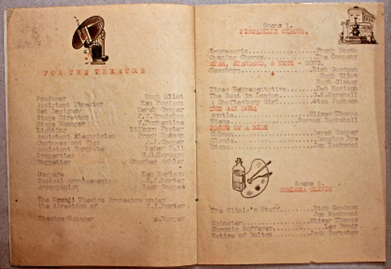By Sears Eldredge
Kranji Hospital Camp
Approximately 14 miles north of the Gaol was the POW hospital for chronic cases at Kranji.
A goodly number of entertainers had been sent to Kranji when the Selarang encampment was dispersed, or were already there with chronic illnesses. These included many talented musicians, theatrical entertainers, and artists, who were noted in earlier Changi POW Camp blogs, including Denis East, violinist; Ken Morison, compere; Derek Cooper, set design; F. W. Bradshaw, stage director; Milburn Foster, lighting; the American J. J. Porter, musical arrangements and orchestra conductor; Oliver Thomas and Rich Goodman, actors; and Jon Mackwood and Norman Backshall, female impersonators.
The important newcomers were Hugh Eliot, producer; and Bill Norways, props (who was also the artist for all their program needs).

Courtesy of Toby Norways.[1]
Oliver Thomas: Reminiscences of Kranji Theatre:
“At Kranji there was a permanent theatre . . . The lighting was good particularly at Kranji where the same large hut served as our theatre throughout the 18 months we were there; there was no problem with electricity & of course there were excellent technicians among the P.O.W’s.”[2]
For those of us like myself who had come to Kranji — as far as the British (& Australian) army authorities were concerned as actors, musicians or singers — we had for the duration of our captivity become professionals. How much I personally owe to this fact is quite immeasurable. We had to practice an art. One or two of the actors I remember were doctors. I remember feeling impatient with their lack of professionalism as actors. I also remember being impatient with some of the ‘professional’ actors who had been in repertory companies before joining up and who tended to learn their lines inexactly & to paraphrase.[3]
. . . We became almost a repertory company & put on a number of plays. Copies had been found of some — sets of Shaw’s plays for example, others were remembered. I don’t recall any being written[4]… At Kranji, I remember doing Shaw’s ‘Man of Destiny.’ (I don’t remember what part I had.) We did ‘Rope’; this was a case, I’m almost sure of somebody remembering the play. My part was the principal one (played by James Stewart in the film?) My shoe was built up to produce a limp. No mimicking powers require in this part. In some play [?] I was a wisecracking American woman. What play?

Courtesy of Toby Norways.
Obviously, as the programs above indicates, at some point, they also did a show entitled, Cavalcade.[5]
Return to Oliver’s memories:
An artist, Derek Cooper, still living did some scene painting too. Derek incidentally had a very good line in female impersonation — a sort of comfortable easy going, no longer quite young woman — I had the impression female-impersonating had quite a disturbing affect on the actor.[6] This was not the case in Derek’s impersonation.[7]
[Historical note from Dr. Huxtable’s diary] Early in August [1945] the Japanese authorities closed our theatre, ordered the stage to be dismantled and advised us of a big move at or before the end of August . . .. The loss of the theatre and of our entertainment concerts and plays is somewhat depressing. We are still allowed to use the big wooden hall on Sunday nights for Church Services but not for the evening lectures, all of which are now countermanded.[8]
Final statement by Thomas on theatre in Kranji:
“I think a strong element in the entertainment being put on was to recall life before our captivity. The audience who saw our plays forgot for the moment they were prisoners and ‘went to the theatre’ ‘did a show’ or whatever. (Incidentally nobody enjoyed the shows more than our Korean guards who wouldn’t have been able to understand a word.)”[9]
[1] This glittery outdoor theatre is never mentioned by Thomas. It may have been an outdoor stage built for the Victory celebration as the setting looks like it could have been recovered from an indoor theatre.
[2] Thomas, Oliver. Transcribed fax letter, 1.
[3] Ibid, 1-2.
[4] Ibid, 1.
[5] Whether this was the Noel Coward play is not known.
[6] A comment, unfortunately, not explored further.
[7] Thomas; 3.
[8] Huxtable, 158.
[9] Thomas, Transcribed fax letter, 1.

